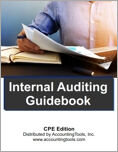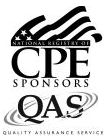Internal Auditing Guidebook (CPE Course)
CPE Credit: 10 hours
Course Type: Downloaded PDF materials with online test
Price (with PDF Textbook): $70
Course Description
A successful internal audit program is an essential tool for determining how well an organization’s processes and controls are functioning. It can identify high-risk areas and determine how well existing controls are mitigating risks. In the Internal Auditing Guidebook, we cover all aspects of the internal auditing function, including governance, risk management, internal controls, fraud prevention and detection, audit evidence, audit sampling, data analytics, how to conduct engagements, and much more. This course is designed to assist in the development of a fine-tuned internal audit department that can help to minimize risks and provide valuable consulting advice to every area of a business.
Author: Steven Bragg
Course Number: AU1032
Table of Contents
Chapter 1. Introduction to Internal Auditing
Chapter 2. Governance
Chapter 3. Risk Management
Chapter 4. Business Processes
Chapter 5. Internal Controls
Chapter 6. Information Technology Auditing
Chapter 7. Fraud Prevention and Detection
Chapter 8. Internal Audit Management
Chapter 9. Audit Evidence
Chapter 10. Internal Audit Working Papers
Chapter 11. Audit Sampling
Chapter 12. Data Analytics
Chapter 13. Conducting Internal Audit Engagements
Learning Objectives
Recognize the responsibilities and reporting relationships of the internal audit staff.
Identify the components of the Institute of Internal Auditors’ code of ethics and practice standards.
Specify the components of the three lines of defense model.
Identify the situations under which a business should and should not retain risk.
Specify the characteristics of an enterprise risk management system.
Recognize the members and responsibilities of the risk management committee.
Recognize the information contained within a risk profile.
Identify the characteristics of a “perfect storm” event.
Identify the reasons why a firm’s systems should be documented.
Specify the different types of flowcharts and how they are used.
Describe the circumstances under which weak controls may be acceptable.
Recognize the methods used to quantify risk.
Specify the characteristics of the different types of controls.
Recognize the different types of control deficiencies.
Identify the ranking criteria for IT audits.
Identify the audit tests used to examine IT controls.
Specify the reason for weaknesses in database security.
Specify the reports associated with the controls of an IT vendor.
Identify the various opportunities to commit fraud.
Recognize the rationalizations for committing fraud.
Specify the types of fraud encountered by a business.
Specify the methods used to reduce the perceived pressure on employees.
Recognize response options when an employee has committed fraud.
Cite the indicators of fraud.
Identify the various fraud investigation techniques.
Specify the metrics that may be used to measure the internal audit department.
Recognize the sources of audit evidence.
Describe the relevance and reliability concepts.
Identify the normal contents of audit working papers.
Specify the characteristics of the different types of sampling.
Recognize the issues associated with sampling units.
Identify the conditions under which sampling variances are acceptable.
Identify the characteristics of high-validity data.
Specify the characteristics of the different types of deficiencies.
Level: Overview
Instructional Method: QAS Self-Study
NASBA Category: Auditing
Prerequisites: None
Advance Preparation: None
Latest Review Date: July 2023
Program Registration Requirements: Click on "Purchase Course" near the top of this page to pay for and access the course. You will then be able to download the course as a PDF file, then take an on-line examination, and then download a certificate of completion if you pass the examination.
Program Refund Policy: For more information regarding administrative policies concerning complaints, refunds, and other matters, see our policies page.
AccountingTools, Inc. is registered with the National Association of State Boards of Accountancy (NASBA) as a sponsor of continuing professional education on the National Registry of CPE Sponsors. State boards of accountancy have the final authority on the acceptance of individual courses for CPE credit. Complaints regarding registered sponsors may be submitted to the National Registry of CPE Sponsors through its website: www.nasbaregistry.org.
The NASBA sponsor identification number for Accountingtools, Inc. is 115881.
AccountingTools is an IRS Approved Continuing Education Provider. We are compliant with the requirements for continuing education providers (as described in sections 10.6 and 10.9 of the Department of Treasury’s Circular No. 230 and in other IRS guidance, forms, and instructions). Our IRS Approved Continuing Education Provider number is 72821.


